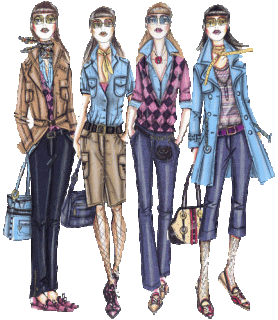Interview with Richard Gray - fashion illustration as a career
From the fundamentals of fashion design
by Richard Sorger & Jenny Udale
Please describe your job.
I am commissioned to create fashion illustrations according to the client's creative brief. The client can vary, from editorial - magazines and books - or could be a couture, pret-a-porter or high-street designer. I am expected to create a rough/line illustration initially, to showcase my ideas and in response to what I have been asked to do. If everyone involved is happy with this, I will then complete the finished artwork, all within a set time and deadline.
Who are your clients and/or who have you worked for?
The designers/clients I have worked for include: Alexander Mcqueen, Givenchy, Agent Provocateur, Vivienne Westwood, Miguel Adrover, Julien MacDonald, Kylie Minogue and William Baker, Boudicca, Oasis, Printemps.
Editorially, I have worked for Vogue Pelle, for Anna Piaggi's D.P. pages for Vogue Italia, V magazine, Madame Figaro, Flaunt, The Observer magazine, Vogue Gioiello, Los Angeles Times magazine, Sleek, The Independent on Saturday magazine, Mixte, Io Donna, Jalouse (USA), Entertainment Weekly, amongst many others.
What was your career path to your current job for?
I studied my degree in Fashion Design at Middlesex University, UK. During this period, I was entered for an illustration competition in Italy celebrating the great fashion illustrator Antonio Lopez. I didn't win, but I came fourth, and was invited to go to Milan to meet Anna Piaggi of Vogue Italia. From this meeting I was asked to create illustrations for her D.P. pages in Vogue Italia, and also for Vanity magazine. On graduating, these first commissions made it much easier to get other people to see my portfolio, and I pursued my interest in fashion illustration as a career from then on.
What do you do on an average day?
Each day can vary so much from the next, depending on the turnaround of deadlines and the amount of time between them. I could be researching ideas, creating initial concept sketches, or creating final artwork.
What are your normal working hours?
My average working day is probably between 12 and 15 hours, due to the turnaround of work for deadlines. It can, however, be much less than that, and occasionally be much more, and it isn't unknown to work right through the night if necessary to get work completed to deadline.
The flipside of this is that you can potentially also get several days off in a row if you are between commissions. Unless you have determinedly structured your life to be this way, the demands of the job means that it is unlikely to ever be 9 to 5, Monday to Friday.
What are the essential qualities needed for your job?
Creativity, the ability to understand a client's creative brief and what they are trying to achieve from your work, and the limitations or expectations of work created towards specific markets. Discipline to make sure that work is done to deadline, even if it means late nights.
The ability to sometimes think outside the brief, and to make sure that your personality still comes through in your work - the reason why you have been approached in the first place.
How creative a job do you have?
Very creative indeed. It's the whole reason a client will come to you.
What kind of team do you work with?
I do not have any team at all, there is nothing to delegate. Any ideas have to be drawn by me, and painting is done by myself. The nearest it comes to teamwork is obviously when the client gets in touch and they will be in contact with my agent, and I will then be given the creative brief by the art director of the client.
What is the best bit about your job?
The best part of my job is the unpredictability of the working year. The surprise and delight when designers or magazines you admire ask you to work with them, and the variation in commissions from one to the next. I think it helps that I have not restricted my career to one single style, so I have a lot of variety in what I am asked to do.
And the worst?
It sometimes feels like there are not enough hours in the day, but apart from that there is nothing to complain about.
Any advice you would give to someone wanting to get a job in your area of fashion?
I think illustration is a career that can be very fulfilling, but like all freelance careers there are no guarantees. Not all people will like what you do, as any art and illustration is such a subject form, so don't be put off if you find your work is not to everyone's tastes, but always listen to constructive criticism and know when to ignore it. Most of all, as important as it is to be creative it is i important to be reliable. The client wants the work done with as little fuss as possible. Everyone is busy, multi-tasking, with a million problems to solve everyday. If you make their life that little bit easier by completing your work for them to deadline, completely answering their creative brief, they are more likely to come back to you again.

 We can do it together !
We can do it together ! 

 We can do it together !
We can do it together ! 



 from Gray's website? Thanks for the response !
from Gray's website? Thanks for the response !



